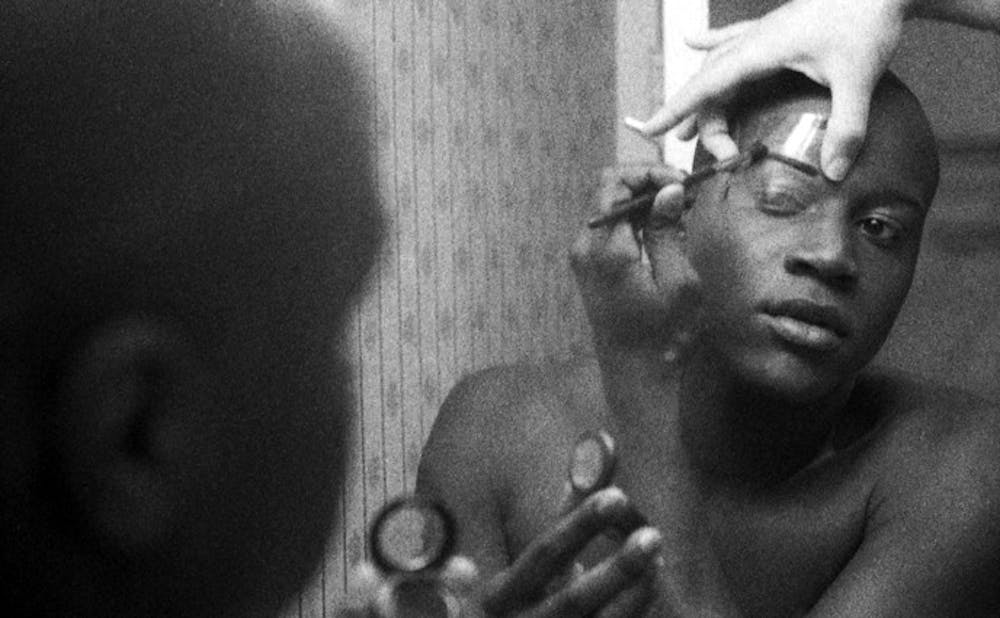In the world of underground house balls, extravagance and 'realness' reign supreme. And at the Center for Documentary Studies reigns “Legendary: Inside the House Ballroom Scene,” the compilation of black-and-white and color photographs by Gerard H. Gaskin, winner of the 2012 CDS/Honickman First Book Prize in Photography.
These are glimpses that focus on the groups and the individuals, bringing visitors into a distant and, until now, undocumented scene. The photographs are as captivating and diverse as their subjects: gay and transgender men and women, the majority of whom are African-American and Latino/a. Members compete in the late-night pageants by “houses,” themselves becoming works of art as they dance and flaunt vibrant makeup, grandiose costumes and fearless grace. A group of men pose together, wearing nothing but bright boxers, a couple of chains, sunglasses and bejeweled crowns. Across the room are different couples posing together. Jlin applies eyebrow makeup; Gerald models a tiny bowler hat with an enormous feather; Jennifer, wearing high hair and a red sequined dress, laughs; the audience is in rapt attention, some cheering, some heckling and some waiting in suspense.
Two color portraits are staggering. Tez, covered in blue body paint, wears silver lipstick, turquoise contacts and a white and violet wig, covered in the crinkled folds of a golden costume. In another photograph, a lone figure wears white face makeup and pink sunglasses, posing in front of a mural depicting an armchair. Both are commanding in their singularity and both are relentless with stoic intensity.
Most striking is the subtlety of the black-and-white photographs, interspersed among the more vivid works and focused on moments of stillness. The gazes are unwavering and quietly unapologetic. Some smile slightly and others remain blank. Although they seem candid at first, the portraits are guarded. Perhaps the most honest expression is that of ‘Gerard, Eric Bazaar Ball, Manhattan, 1998.’ Gerard, donning a plaid tie and a white, lopsided brimmed hat, regards the camera softly and imparts a feeling of depth—tragedy, even—while a fellow performer behind him, out of focus, smiles. In ‘Mother’s Day Ball, Manhattan, 2001,’ an audience waits in a well-lit room as the performer gazes at viewers to his side. With wiry glasses, mesh hat, pressed collared shirt and a hand looped through the belt buckle, he exudes a nonchalant confidence that challenges his audience.
‘Kelli, Legends Ball, Jersey City, 1995’ leaves viewers stunned. Kelli, wearing a black bra underneath an oversized blazer, is defiant in her beauty. She smokes a cigarette. Her eyebrows and eye makeup are immaculate, her hair is set in a short finger wave and her hands are placed casually but suggestively. The photograph is black-and-white and uncluttered, yet viewers sense that somehow, they remain disconnected from Kelli and on the outside of her wild, thriving world.
Gaskin has realized every documentarian’s dream: to be wholly welcomed into a community—here, one that celebrates the self, however many selves there may be. Gaskin’s search for beauty brings us “Legendary,” navigating through the electrifying house ballroom scene and its most thrilling and exquisite moments, people and spaces.
“Legendary: Inside the House Ballroom Scene” will be on display until Feb. 22 at the Juanita Kreps Gallery at the Center for Documentary Studies. For more information, visit http://www.cdsporch.org/archives/20374.
Get The Chronicle straight to your inbox
Signup for our weekly newsletter. Cancel at any time.

